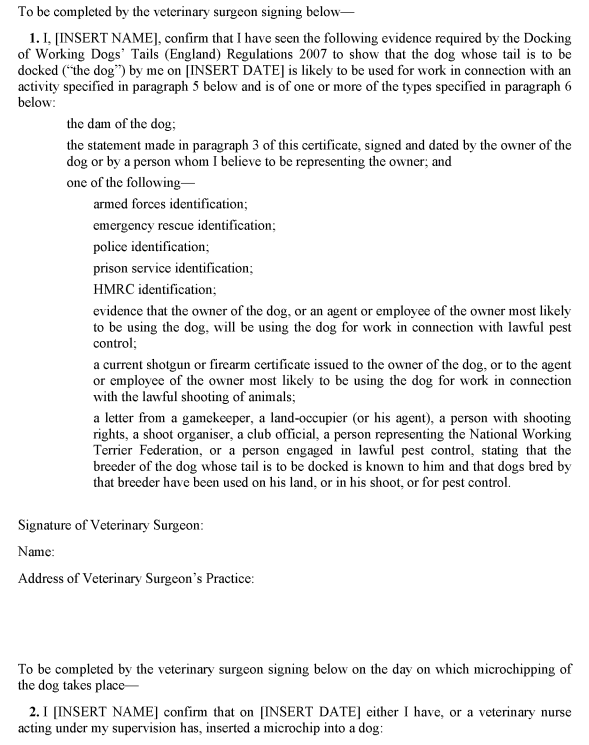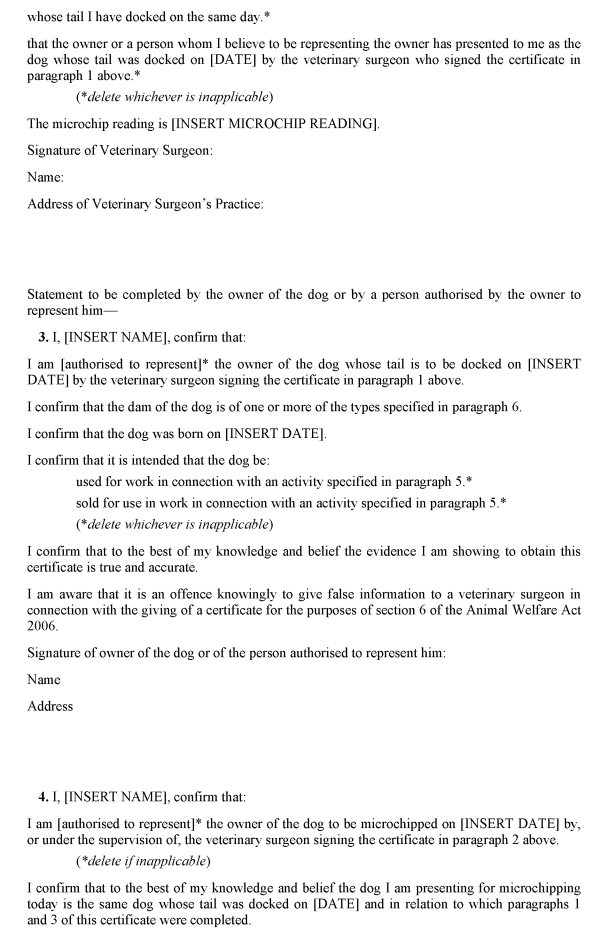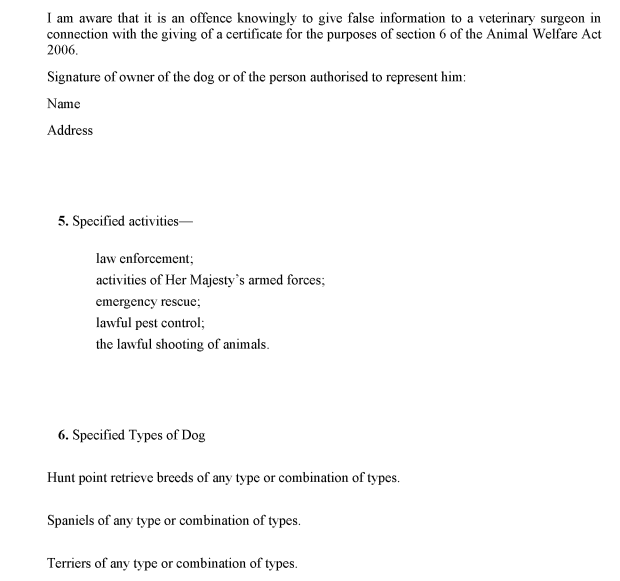Statutory Instruments
2007 No. 1120
ANIMALS, ENGLAND
animal welfare
The Docking of Working Dogs’ Tails (England) Regulations 2007
Made
30th March 2007
Coming into force
6th April 2007
The Secretary of State, as the appropriate national authority in relation to England, makes the following Regulations in exercise of the powers conferred by section 6(4), (5), (6), (8) and (14) of the Animal Welfare Act 2006(1).
In accordance with section 6(15) of that Act, the Secretary of State has consulted those persons appearing to him to represent interests with which these Regulations are concerned as he considered appropriate.
In accordance with section 61(2) of that Act, a draft of this instrument has been laid before Parliament and approved by a resolution of each House of Parliament.
Modifications etc. (not altering text)
C1Regulations applied (with modifications) (10.5.2021) by The West Yorkshire Combined Authority (Election of Mayor and Functions) Order 2021 (S.I. 2021/112), arts. 1(4), 35(1)(2), Sch. 5 para. 48
Title, commencement and applicationE+W
1. These Regulations—
(a)may be cited as the Docking of Working Dogs’ Tails (England) Regulations 2007;
(b)come into force on 6th April 2007;
(c)apply in England only.
Commencement Information
I1Reg. 1 in force at 6.4.2007, see reg. 1(b)
InterpretationE+W
2. In these Regulations—
“armed forces identification” means evidence that the person presenting the identification is a member of one of Her Majesty’s armed forces, or is otherwise employed by or contracted to work for one of Her Majesty’s armed forces;
“club official” means a person who serves a shoot club in an official capacity;
“emergency rescue identification” means evidence that the person presenting the identification is a member of a body providing an emergency rescue service;
“gamekeeper” means a person engaged by a person with shooting rights to preserve, protect or rear animals and to manage or assist with the management of a shoot;
“HMRC identification” means evidence that the person presenting the identification is an employee of Her Majesty’s Revenue & Customs;
“land-occupier” means a person who occupies land where a shoot takes place;
“person with shooting rights” means an owner or lessee of shooting rights;
“police identification” means evidence that the person presenting the identification is a police officer, or is otherwise employed by or contracted to work for a [F1local policing body or chief officer of police];
“prison service identification” means evidence that the person presenting the identification is an authorised employee of either Her Majesty’s Prison Service or of an organisation contracted to provide custodial services on behalf of the Secretary of State;
“shoot” means an occasion on which animals are shot for sporting purposes;
“shoot organiser” means any person responsible for the overall organisation of a shoot;
“specified type of work” means work in connection with law enforcement, activities of Her Majesty’s armed forces, emergency rescue, lawful pest control, or the lawful shooting of animals.
Textual Amendments
F1Words in reg. 2 substituted (16.1.2012) by The Local Policing Bodies (Consequential Amendments) Regulations 2012 (S.I. 2012/61), regs. 1(1), 3(2)
Modifications etc. (not altering text)
C2Reg. 2 modified (20.12.2023) by The York and North Yorkshire Combined Authority Order 2023 (S.I. 2023/1432), arts. 1(2), 33(2), Sch. 5 para. 48(2)
Commencement Information
I2Reg. 2 in force at 6.4.2007, see reg. 1(b)
Certification requirementsE+W
3.—(1) A veterinary surgeon may certify that he has seen evidence that a dog is likely to be used for a specified type of work and is a dog of a specified type, where—
(a)he is satisfied that the dam of the dog is of one or more of the types specified in Schedule 1;
(b)he reasonably believes that the dog is not more than 5 days old; and
(c)the owner of the dog, or another person whom he reasonably believes to be representing the owner, has shown him the evidence specified in paragraph (2).
(2) The evidence is—
(a)the dam of the dog;
(b)a completed statement, signed and dated by the owner of the dog or by another person whom the veterinary surgeon to whom it is presented reasonably believes to be representing the owner, made in paragraph 3 of a certificate in the form prescribed in Schedule 2; and
(c)one of the following—
(i)where the dog is presented for certification on behalf of one of Her Majesty’s armed forces, armed forces identification;
(ii)where the dog is presented for certification on behalf of a body providing an emergency rescue service, emergency rescue identification;
(iii)where the dog is presented for certification on behalf of a [F2local policing body or chief officer of police], police identification;
(iv)where the dog is presented for certification on behalf of Her Majesty’s Prison Service or of an organisation contracted to provide custodial services on behalf of the Secretary of State, prison service identification;
(v)where the dog is presented for certification on behalf of Her Majesty’s Revenue & Customs, HMRC identification;
(vi)evidence that the owner of the dog, or an agent or employee of the owner most likely to be using the dog, will be using the dog for work in connection with lawful pest control;
(vii)a current shotgun or firearm certificate issued to the owner of the dog, or to the agent or employee of the owner most likely to be using the dog for work in connection with the lawful shooting of animals;
(viii)a letter from a gamekeeper, a land-occupier (or his agent), a person with shooting rights, a shoot organiser, a club official, a person representing the National Working Terrier Federation, or a person engaged in lawful pest control, stating that the breeder of the dog whose tail is to be docked is known to him and that dogs bred by that breeder have been used (as the case may be) on his land, or in his shoot, or for pest control.
(3) Any certification given under paragraph (1) shall be made in paragraph 1 of a certificate in the form prescribed in Schedule 2.
Textual Amendments
F2Words in reg. 3(2)(c)(iii) substituted (16.1.2012) by The Local Policing Bodies (Consequential Amendments) Regulations 2012 (S.I. 2012/61), regs. 1(1), 3(3)
Commencement Information
I3Reg. 3 in force at 6.4.2007, see reg. 1(b)
Identification of docked dogsE+W
4.—(1) In order to be identified as a subsection (3) dog as required by section 6(8) of the Animal Welfare Act 2006 a dog must be microchipped—
(a)by a veterinary surgeon or a veterinary nurse acting under the supervision of a veterinary surgeon; and
[F3(b)using a microchip which complies with either ISO standard 11784 or Annex A to ISO standard 11785 of the International Standards Organisation’s standards for microchips.]
[F3(b)with a microchip which—
(i)has a unique number which includes the manufacturer’s code;
(ii)is compliant with ISO standard 11784:1996 of the International Standards Organisation’s standards for microchips;
(iii)is compliant with all of ISO standard 11785:1996 of the International Standards Organisation’s standards for microchips apart from Annex A; and
(iv)responds to a transponder which operates at 134.2 kilohertz and conforms with the FDXB protocol set out in ISO standards 11784:1996 and 11785:1996.]
(2) A dog may only be microchipped for the purposes of these Regulations after the owner, or a person whom the veterinary surgeon who is to carry out or supervise the microchipping reasonably believes to be representing the owner, has made a signed and dated statement in paragraph 4 of a certificate in the form prescribed in Schedule 2.
(3) The veterinary surgeon who carries out or supervises the microchipping must certify that fact in paragraph 2 of a certificate in the form prescribed in Schedule 2.
Textual Amendments
F3Reg. 4(1)(b) substituted (temp. until 24.2.2022) (24.2.2015) by The Microchipping of Dogs (England) Regulations 2015 (S.I. 2015/108), regs. 1(b)(c), 16
Commencement Information
I4Reg. 4 in force at 6.4.2007, see reg. 1(b)
Barry Gardiner
Parliamentary Under Secretary of State
Department for Environment, Food and Rural Affairs
30th March 2007
Regulation 3(1)(a)
SCHEDULE 1E+WSpecified Types of Dog
Commencement Information
I5Sch. 1 in force at 6.4.2007, see reg. 1(b)
Hunt point retrieve breeds of any type or combination of types.
Spaniels of any type or combination of types.
Terriers of any type or combination of types.
Regulations 3 and 4
SCHEDULE 2E+WForm of Certificate
Commencement Information
I6Sch. 2 in force at 6.4.2007, see reg. 1(b)
“ANIMAL WELFARE ACT 2006, section 6E+WThe Docking of Working Dogs’ Tails (England) Regulations 2007
EXPLANATORY NOTE
(This note is not part of the Regulations)
Under section 6 of the Animal Welfare Act 2006 (c.45), working dogs may be exempted by regulations from the prohibition upon the removal of the whole or any part of a dog’s tail, otherwise than for the purpose of its medical treatment.
Regulation 3 sets out the requirements to be observed before a veterinary surgeon may certify that the dog is a working dog. Regulation 3(1)(a) and Schedule 1 specify the types of dog that are capable of being certified, and regulation 3(1)(c) and (2) describes the further evidence (concerning the likelihood that the dog will be used for certain work) that is required to be shown to a veterinary surgeon in order to obtain such a certificate. Regulation 4 prescribes the way in which a dog whose tail is docked is to be identified by microchipping. Schedule 2 prescribes the form in which the certificate is to be given.
A regulatory impact assessment has been prepared for these Regulations and placed in the library of each House of Parliament; copies can be obtained from the Animal Welfare Division, Department for Environment, Food and Rural Affairs, 1A Page Street, London SW1P 4PQ.
2006 c.45. The appropriate national authority is defined in section 62(1) of the Act.


